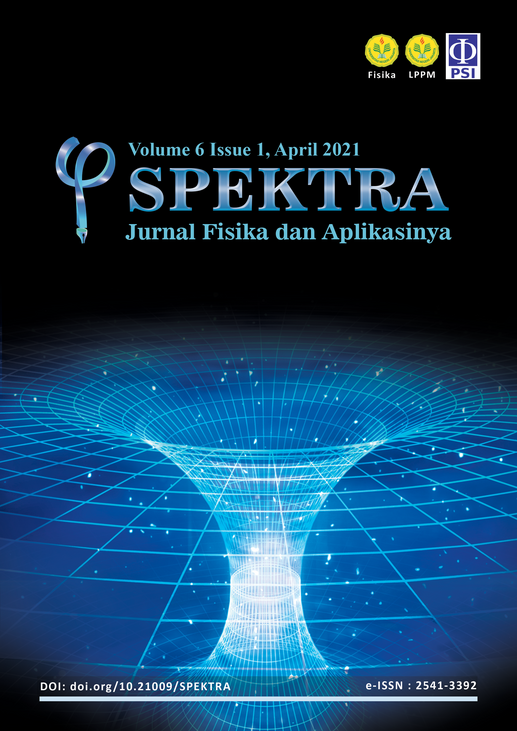SEED MEDIATED SYNTHESIS OF HEXAGONAL S-DOPED ZnO NANOROD AND ITS PHYSICAL PROPERTIES
DOI:
https://doi.org/10.21009/SPEKTRA.061.03Keywords:
ZnO nanorod, sulfur doping, hexagonal, seed-mediated hydrothermalAbstract
Sulfur-doped zinc oxide (S-ZnO) nanorod has been successfully synthesized via the seed-mediated hydrothermal method with different sulfur concentrations (0%, 1%, 2.5%). This research aims to study the influence of the concentration of sulfur on the structure, morphology, and optical properties of ZnO as a promising material in a wide range of applications. Crystal structure, morphology, and optical properties of the samples were characterized using X-Ray Diffraction (XRD), Field Emission Electron Scanning Microscopy (FESEM), and UV-Vis Spectroscopy, respectively. The XRD pattern shows the strongest peak at 2θ = 34.43° for crystal orientation of (002). The crystallinity properties of the S-ZnO sample are higher compared to the ZnO sample. The FESEM images of the 1% S-ZnO sample exhibit the highest nanorod density arrangement. The optical absorbance of the higher sulfur dopant possesses a higher optical absorption peak on the UV-Vis spectrum. The results indicate that S doping to ZnO can alter the structural, morphological, and optical properties of ZnO.
References
[2] E. Hidayanto, H. Sutanto, and K. S. Firdausi, “Pembuatan Lapisan Fotokatalis Zinc Oxide (ZnO) dengan Teknik Spray Coating dan Aplikasinya pada Pengering Jagung,” Berk. Fis, vol. 16, no. 4, pp. 119-124, 2013.
[3] Z. Lin and J. Song, “Piezoelectric Nanogenerators Based on Zinc Oxide Nanowire Arrays Author(s): Zhong Lin Wang and Jinhui Song Source,” Science (80), vol. 312, no. 5771, pp. 242-246, 2006.
[4] H. Morkoc and U. Ozgur, “Zinc Oxide: Fundamentals, Materials and Device Technology,” in Processing, Devices, and Heterostructures, Federal Republic ofGerman: WILEY-VCH Verlag GmbH & Co. KGaA, Weinheim, pp. 446-454, 2009.
[5] M. Torabi et al., “We are IntechOpen, the world ’ s leading publisher of Open Access books Built by scientists, for scientists TOP 1 %,” Intech, vol. 1, no. tourism, p. 13, 2016.
[6] O. Bayram et al., “Investigation of structural, morphological and optical properties of Nickel-doped Zinc oxide thin films fabricated by co-sputtering,” J. Mater. Sci. Mater. Electron, vol. 30, no. 4, pp. 3452-3458, 2019.
[7] G. G. Rusu et al., “Preparation and characterization of Mn-doped ZnO thin films,” J. Optoelectron. Adv. Mater, vol. 12, no. 4, pp. 895-899, 2010.
[8] I. Iwantono et al., “Enhanced charge transfer activity in Au nanoparticles decorated ZnO nanorods photoanode,” Phys. E Low-Dimensional Syst. Nanostructures, vol. 111, pp. 44-50, 2019.
[9] F. A. Garcés et al., “Structural Analysis of ZnO(: Al,Mg) Thin Films by X-ray Diffraction,” Procedia Mater. Sci, vol. 8, pp. 551–560, November 2015.
[10] A. S. Alshammari et al., “Visible-light photocatalysis on C-doped ZnO derived from polymer-assisted pyrolysis,” RSC Adv, vol. 5, no. 35, pp. 27690-27698, 2015.
[11] R. Jothi Ramalingam et al., “Synthesis, characterization and optical properties of sulfur and fluorine-doped ZnO nanostructures for visible light utilized catalysis,” Optik (Stuttg), vol. 148, pp. 325-331, 2017.
[12] V. Kumari et al., “S-, N- and C-doped ZnO as semiconductor photocatalysts: A review,” Front. Mater. Sci, vol. 13, no. 1, pp. 1-11, 2019.
[13] A. Khan et al., “A novel fabrication methodology for sulfur-doped ZnO nanorods as an active photoanode for improved water oxidation in visible-light regime,” Nanotechnology, vol. 28, no. 5, pp.1-9, 2017.
[14] E. Maryanti, “Sintesis Mikro Partikel ZnO Terdoping Sulfur Alam ( ZnO : S ) Melalui Metode Mechanochemical,” pp. 137-142, 2013.
[15] D. Polsongkram et al., “Effect of synthesis conditions on the growth of ZnO nanorods via hydrothermal method,” Phys. B Condens. Matter, vol. 403, no. 19-20, pp. 3713-3717, 2008.
[16] Y. Tao et al., “The effect of seed layer on morphology of ZnO nanorod arrays grown by hydrothermal method,” J. Alloys Compd, vol. 489, no. 1, pp. 99-102, 2010.
Downloads
Published
How to Cite
Issue
Section
License
SPEKTRA: Jurnal Fisika dan Aplikasinya allow the author(s) to hold the copyright without restrictions and allow the author(s) to retain publishing rights without restrictions. SPEKTRA: Jurnal Fisika dan Aplikasinya CC-BY or an equivalent license as the optimal license for the publication, distribution, use, and reuse of scholarly work. In developing strategy and setting priorities, SPEKTRA: Jurnal Fisika dan Aplikasinya recognize that free access is better than priced access, libre access is better than free access, and libre under CC-BY or the equivalent is better than libre under more restrictive open licenses. We should achieve what we can when we can. We should not delay achieving free in order to achieve libre, and we should not stop with free when we can achieve libre.
 SPEKTRA: Jurnal Fisika dan Aplikasinya is licensed under a Creative Commons Attribution 4.0 International License.
SPEKTRA: Jurnal Fisika dan Aplikasinya is licensed under a Creative Commons Attribution 4.0 International License.
You are free to:
Share - copy and redistribute the material in any medium or format
Adapt - remix, transform, and build upon the material for any purpose, even commercially.
The licensor cannot revoke these freedoms as long as you follow the license terms.

 E-ISSN 2541-3392
E-ISSN 2541-3392  Focus & Scope
Focus & Scope  Editorial Team
Editorial Team  Reviewer Team
Reviewer Team  Author Guidelines
Author Guidelines  Article Template
Article Template  Author Fee
Author Fee  Publication Ethics
Publication Ethics  Plagiarism Policy
Plagiarism Policy  Open Access Policy
Open Access Policy  Peer Review Process
Peer Review Process  Retraction & Correction
Retraction & Correction  Licensing & Copyright
Licensing & Copyright  Archiving & Repository
Archiving & Repository  Contact
Contact  Mendeley
Mendeley 

